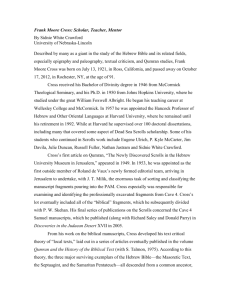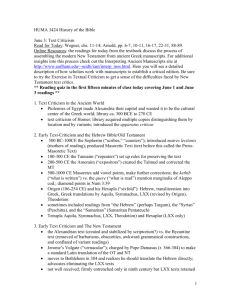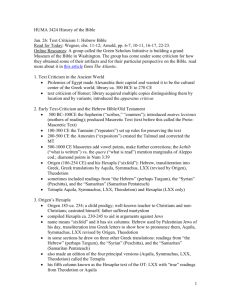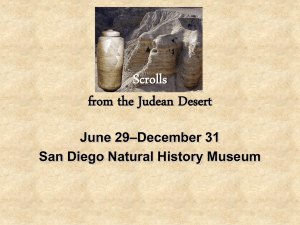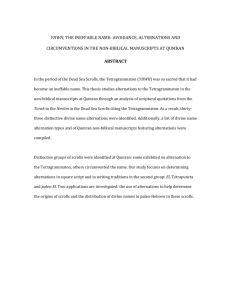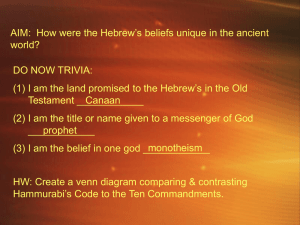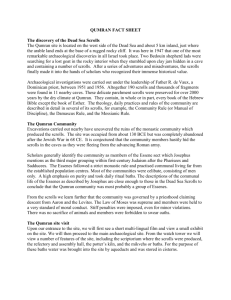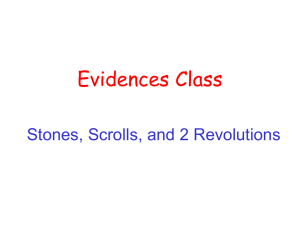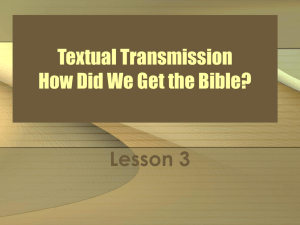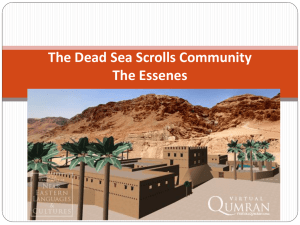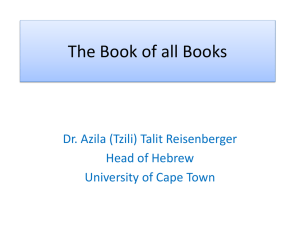The History of the Text of the Hebrew Bible, with Particular Attention
advertisement
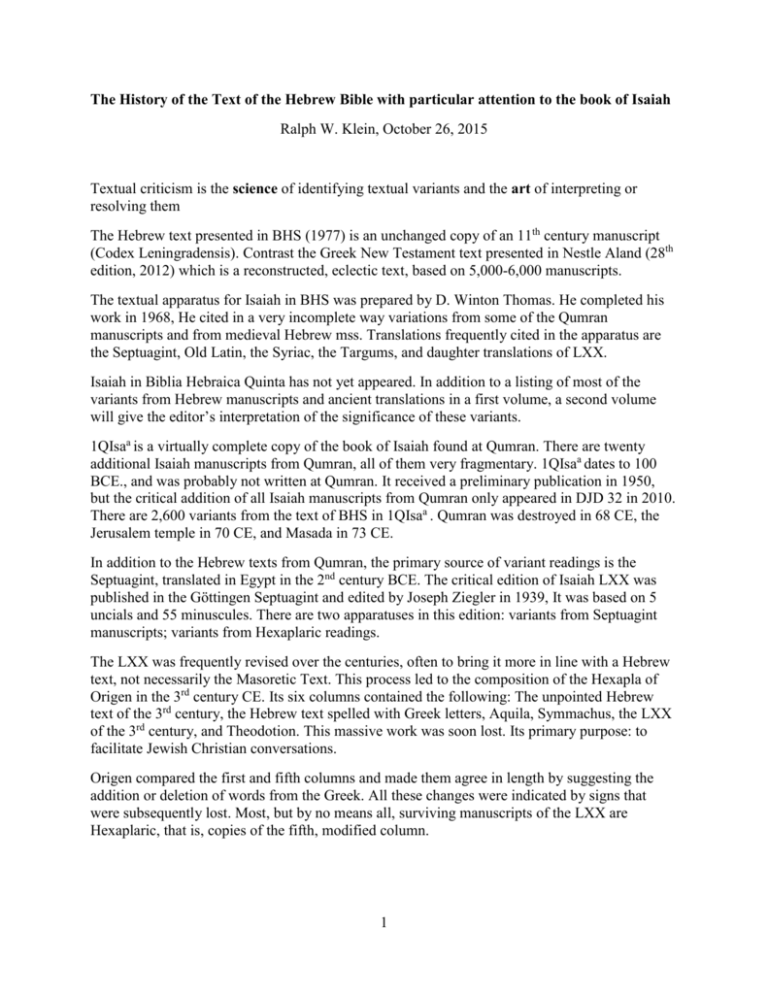
The History of the Text of the Hebrew Bible with particular attention to the book of Isaiah Ralph W. Klein, October 26, 2015 Textual criticism is the science of identifying textual variants and the art of interpreting or resolving them The Hebrew text presented in BHS (1977) is an unchanged copy of an 11th century manuscript (Codex Leningradensis). Contrast the Greek New Testament text presented in Nestle Aland (28th edition, 2012) which is a reconstructed, eclectic text, based on 5,000-6,000 manuscripts. The textual apparatus for Isaiah in BHS was prepared by D. Winton Thomas. He completed his work in 1968, He cited in a very incomplete way variations from some of the Qumran manuscripts and from medieval Hebrew mss. Translations frequently cited in the apparatus are the Septuagint, Old Latin, the Syriac, the Targums, and daughter translations of LXX. Isaiah in Biblia Hebraica Quinta has not yet appeared. In addition to a listing of most of the variants from Hebrew manuscripts and ancient translations in a first volume, a second volume will give the editor’s interpretation of the significance of these variants. 1QIsaa is a virtually complete copy of the book of Isaiah found at Qumran. There are twenty additional Isaiah manuscripts from Qumran, all of them very fragmentary. 1QIsaa dates to 100 BCE., and was probably not written at Qumran. It received a preliminary publication in 1950, but the critical addition of all Isaiah manuscripts from Qumran only appeared in DJD 32 in 2010. There are 2,600 variants from the text of BHS in 1QIsaa . Qumran was destroyed in 68 CE, the Jerusalem temple in 70 CE, and Masada in 73 CE. In addition to the Hebrew texts from Qumran, the primary source of variant readings is the Septuagint, translated in Egypt in the 2nd century BCE. The critical edition of Isaiah LXX was published in the Göttingen Septuagint and edited by Joseph Ziegler in 1939, It was based on 5 uncials and 55 minuscules. There are two apparatuses in this edition: variants from Septuagint manuscripts; variants from Hexaplaric readings. The LXX was frequently revised over the centuries, often to bring it more in line with a Hebrew text, not necessarily the Masoretic Text. This process led to the composition of the Hexapla of Origen in the 3rd century CE. Its six columns contained the following: The unpointed Hebrew text of the 3rd century, the Hebrew text spelled with Greek letters, Aquila, Symmachus, the LXX of the 3rd century, and Theodotion. This massive work was soon lost. Its primary purpose: to facilitate Jewish Christian conversations. Origen compared the first and fifth columns and made them agree in length by suggesting the addition or deletion of words from the Greek. All these changes were indicated by signs that were subsequently lost. Most, but by no means all, surviving manuscripts of the LXX are Hexaplaric, that is, copies of the fifth, modified column. 1 The effects of the discoveries of the Dead Sea Scrolls on textual theory are best spelled out by Eugene Ulrich, The Dead Sea Scrolls and the Developmental Composition of the Bible (Leiden: Brill, 2015). The books of the Hebrew Bible were “canonized” in this order: Pentateuch, Prophets, and Writings. The tentative dates I would assign to this process are 4th century BCE, 200 BCE, and 100 CE. The last date is the most uncertain, but our records for the whole canonical process are very incomplete. It may not be correct to see the Bible as a complete and closed collection of books of Scripture even at the end of the Second Temple period (70-135 CE). The 200 biblical manuscripts from Qumran date from the third century BCE to the first century CE. They provide clear evidence for variant literary editions of at least five and possibly six books of the twenty-four books in the Hebrew Bible: Exodus, Numbers, Joshua, Jeremiah, Psalms, and the Song of Songs. After the defeats of the Jews in the first and second revolts and their banishment from Jerusalem the Rabbis found themselves with a random collection of scrolls, one copy from the available forms of each book. These scrolls were meticulously copied and outfitted with vowels and accent markings over the next centuries, but there is no evidence that the Rabbis closely compared entire texts and chose the proto-MT because of its textual superiority. The JPS translation of Isaiah, generally a very conservative translation of MT, marks more than 100 readings “meaning of Hebrew uncertain,” and in another 100 cases they emend the Hebrew text. The Qumran Scrolls show that the textual form of the MT was not and is not the central text of the Hebrew Bible, but is simply one of several forms that existed in antiquity. The texts taken to Qumran with all their pluriformity would have been produced by the priests of the Jerusalem temple. The MT texts of Samuel and Hosea are inferior. Some examples from Isaiah MT, Isaiah LXX, and 1QIsa Isa 2:9b-10 (Ulrich, 114-116) MT and LXX So humankind is humbled, and everyone brought low— Do not forgive them! Enter into the rock and hide in the dust from the terror of the LORD and from the glory of his majesty. The haughty eyes of humankind will be brought low and human pride will be humbled; the LORD alone will be exalted in that day. The italicized words are not in 1QIsaa but there is no notice of this in BHS. Isa 2:22 (Ulrich, 117-119) 2 MT and 1QIsaa but lacking in LXX, but there is no notice of this in BHS Avoid mortals who only have breath in their nostrils, for of what account are they? This sentence is probably a secondary gloss. Isa 36:7 (Ulrich, 119-120) MT and 1QIsaa ; LXX lacks the italicized words, but there is no notice of this in BHS. They are included in the parallel text 2 Kgs 18:22. But if you say to me, “We rely on the LORD our God,” --is it not he whose high places and altars Hezekiah has removed. saying to Judah and Jerusalem, “you shall worship before this altar”?-come now, make a wager with my master the king of Assyria…. Isaiah 40:7-8 (Ulrich, 123-124) MT A voice says, “Cry out! And I said, “What shall I cry?” All flesh is grass, all their constancy is like the flower of the field. The grass withers, the flower fades, when the breath of the LORD blows upon it; surely the people is “the grass.” The grass withers, the flower fades, but the word of our God will stand forever. LXX lacks the italicized words, as does 1QIsaa . But a later scribe in 1QIsaa added between the lines and down the left margin these words: when the breath of the LORD blows on it. Surely the people is “the grass.” The grass withers, the flower fades, but the word of our God. Note that the words in bold are redundant. BHS notes that v. 7 (lines 3-5 above) is absent from the LXX with no reference to 1QIsaa and no advice on what to make of this. BHS also adds that surely the people is “the grass” is probably an addition, but this is a literary critical rather than a text critical observation. In any case, no evidence is cited. Isa 63:3 (Ulrich, 126) MT LXX The winepress I have trod alone, and from the peoples there was none with me. I trod on them in my anger and crushed them in my fury: their juice splattered over my garments, and all my robes I have stained 1QIsaa lacks the italicized lines. BHS comments on the spelling of four verbs, but does not note the omission in 1QIsaa 3
